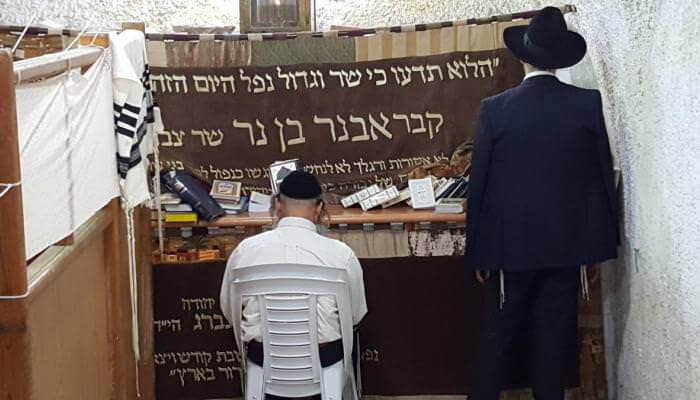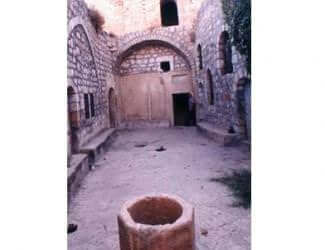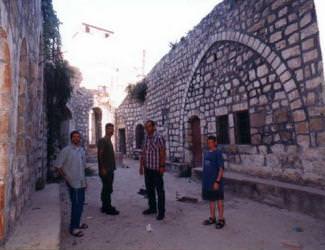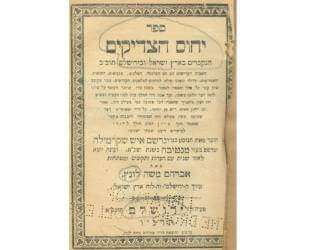Tomb of Abner Ben Ner
King Saul’s top fighter Abner Ben Ner was part of the tumultuous history of the Jewish kingdom. His final resting place is in Hebron, the capital city under King David.

The Tomb of Abner Ben Ner is one of the many gravesites of Biblical figures located in Hebron as described in II Samuel 3:32. “And they buried Abner in Hebron, and the king raised his voice and wept on Abner’s grave, and all the people wept.” According to a medieval Jewish tradition, he was buried near the Tomb of Machpela, which corresponds to the present-day location of the site.

The story of Abner Ben Ner is fraught with intrigue during the trying times of King David, as described in Samuel, Books I and II. Abner ben Ner was King Saul’s cousin and commander-in-chief of his army. After King Saul died in battle, Abner appointed his son, Ishbosheth, as king, leading to rival factions being created. The text described a dramatic battle of self-defense between Abner and Asahel. Abner later met his death at the hands of Yoav, the brother of Asahel at the Battle of Gibeon.

According to tradition, the head of Saul’s son Ishboshet, was buried by Avner’s grave, as described in the Bible, “And David commanded the young men, and they slew them… and hanged them up beside the pool in Hebron. But the head of Ishbosheth they took and buried in the grave of Abner in Hebron.” – II Samuel – Chapter 4:12.

Today, the picturesque Tomb of Abner is a stone structure with several rooms arranged around a courtyard with a Mameluke-style gate, near the Tomb of the Patriarchs. For generations Jewish people have paid their respects to the Patriachs and Matriarchs at the ancient Tomb of Machpela. The nearby Tomb of Abner receives its share of visitors as well.

The building where the tomb was housed fell into disrepair over the years due to neglect. It was refurbished in the mid-1990s. In 1997, the Hebron Redeployment Agreement divided the city into H1, controlled by the PA and H2, controlled by Israel. Since then, the Tomb of Abner is technically in the 15% under Israeli jurisdiction but is in not in the 3% regularly accessible to Jews. Therefore Jewish residents and visitors are only able to visit it 10 times a year. These ten times usually include Rosh Hashannah, one day during the Ten Days of Repentance, Yom Kippur, certain days during chol hamoed Sukkot, Shabbat Parshat Chaya Sarah, certain days during chol hamoed Passover, and on Rosh Chodesh Elul for the annual Hilulat Avot, the celebration commemorating the Patriarchs. On these days, the Isaac Hall in the Tomb of Machpela is also open. These prayer rights came after many petitions and official requests to the government.
Avner ben Ner’s grave is chronicled in various accounts of travelers who visited Hebron throughout history. Rabbi Moses Basola visited Hebron in the year 1522. He stated, “Abner’s grave is in the middle of Hebron; the Muslims built a mosque above it.” His travelogue has been reprinted in the book In Zion and Jerusalem: The Itinerary of Rabbi Moses Basola (1521 – 1523).

In Sefer Yihus ha-Tzaddiqim (Book of Genealogy of the Righteous) a Jewish visitor writes, “At the entrance to the market in Hebron, at the top of the hill against the wall, Abner ben Ner is buried, in a church, in a cave.” The book is a collection of Jewish pilgrimage literature first printed by Gershom ben Asher of Scarmela in Mantua, Italy in 1561. The book was reprinted by Abraham Moshe Lunz in Jerusalem, 1896.

The Tomb of Avner is referenced by Menahem Mendel of Kamenitz, owner of one of the first hotels in the Land of Israel. Before making Israel his permenant home, he wrote of his visits to the land in a book entitled Sefer Korot Ha-Itim, published in 1839. He writes:
“Here I write of the graves of the righteous to which I paid my respects. Hebron – Described above is the character and order of behavior of those coming to pray at the Cave of ha-Machpelah. I went there, between the stores, over the grave of Avner ben Ner and was required to pay a Yishmaeli – the grave was in his courtyard – to allow me to enter.” For the full text in its English translation see, Book of the Occurrences of the Times to Jeshurun in the Land of Israel.
Another author and traveler who reports visiting the tomb was J. J. Benjamin, also known as Benjamin II, a reference to the famous Benjamin of Tudela, the writer and traveler who visited Israel circa 1165. Benjamin writes in his book Eight Years in Asia and Africa (Hanover, 1858):
“On leaving the Sepulchre of the Patriarchs, and proceeding on the road leading to the Jewish quarter, to the left of the courtyard, is seen a Turkish dwelling house, by the side of which is a small grotto, to which there is a descent of several steps. This is the tomb of Abner, captain of King Saul. It is held in much esteem by the Arabs, and the proprietor of it takes care that it is always kept in the best order. He requires from those who visit it a small gratuity.”
In 1912, the famous British-born Jewish scholar Israel Abrahams wrote:
“Hebron was the seat of David’s rule over Judea. Abner was slain here by Joab, and was buried here – they still show Abner’s tomb in the garden of a large house within the city. By the pool at Hebron were slain the murderers of Ishbosheth…” The report comes from his travel writings entitled The Book of Delight and Other Papers.
In modern times, Abner Ben Ner has sparkled the imagination of the creators of popular culture as well. In the 1960 film David and Goliath, Abner is performed by Italian actor Massimo Serato with King Saul played by veteran director Orson Welles. He is portrayed in the 1961 British-Israeli drama A Story of David by Welsh actor David Davies. In the 1976 television miniseries, The Story of David, the younger Abner is performed by Israeli actor Yehuda Efroni and the older Abner is portrayed by British actor Brian Blessed. In the 1985 American drama King David he is played by English actor John Castle with the King David role played by Richard Gere. In the 1997 musical King David, written by Tim Rice and Alan Menken, Abner is played by American actor Timothy Shew. In the 1997 TV movie David, he is played by Richard Ashcroft. In the Brazilian television series Rei Davi (King David) created in 2012, Abner is portrayed by actor Iran Malfitano.
Sources:
* Holy Tombs by Michael Ish Shalom (Jerusalem, Rabbi Kook Foundation Publishing House, 1948)
* Sacred Tombs (Sepulchral Monuments in Palestine) (Hebrew) by Zeev Vilnay. (Jerusalem, Rabbi Kook Foundation Publishing House 1951)
* Tombs of the Righteous in the Land of Israel (Hebrew) by Dr. Zvi Ilan, (Jerusalem: Kanah, 1997)
* Sites in Hebron (United With Hebron Book 4) by David Wilder, (Amazon Digital Services, Inc., 2012)
Originally published on en.hebron.org.il on December 23, 2015 here.